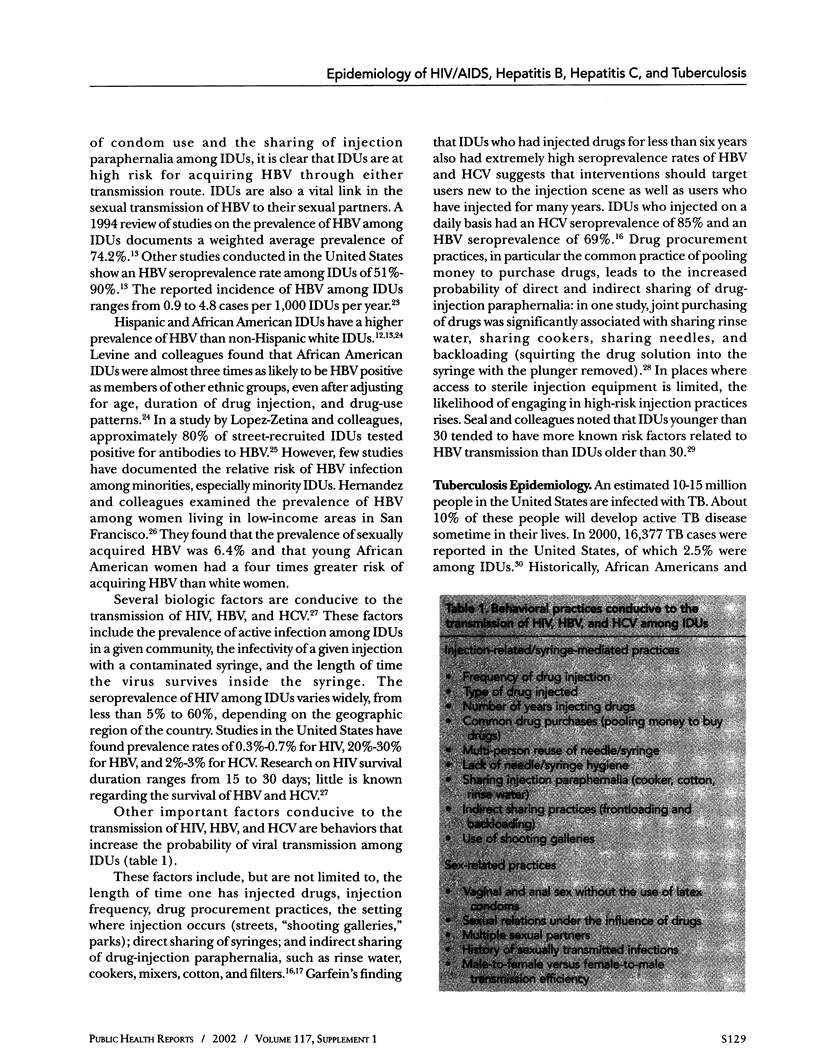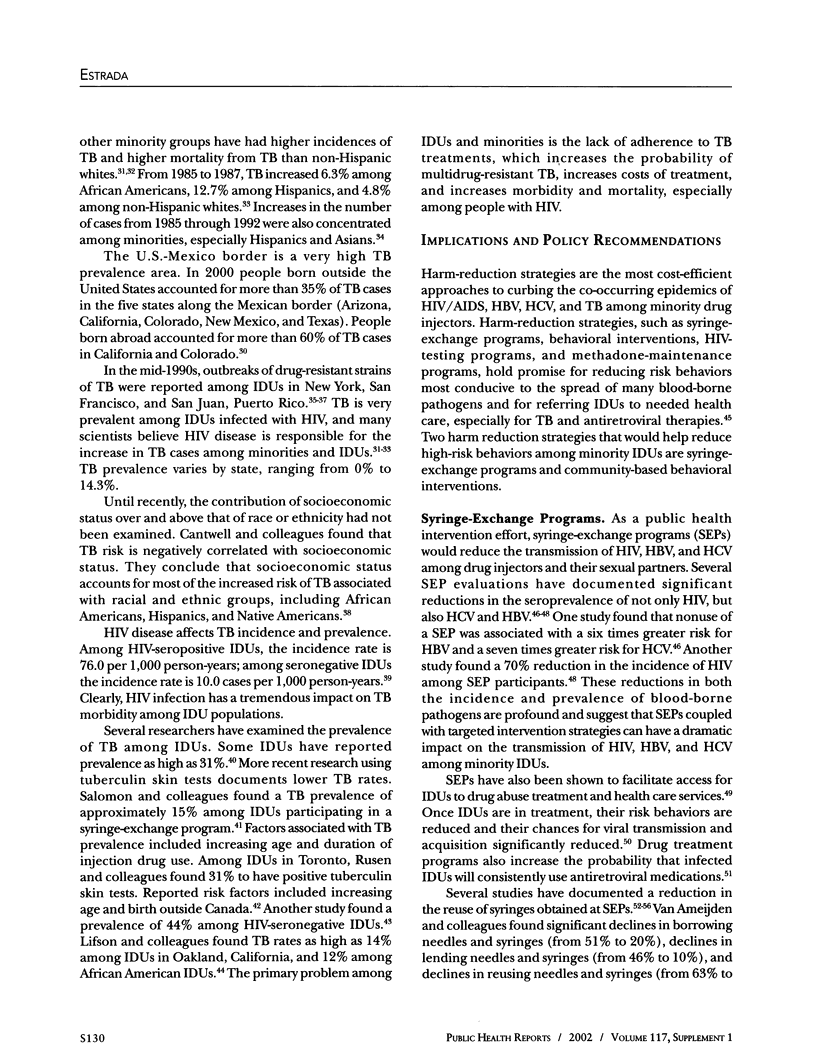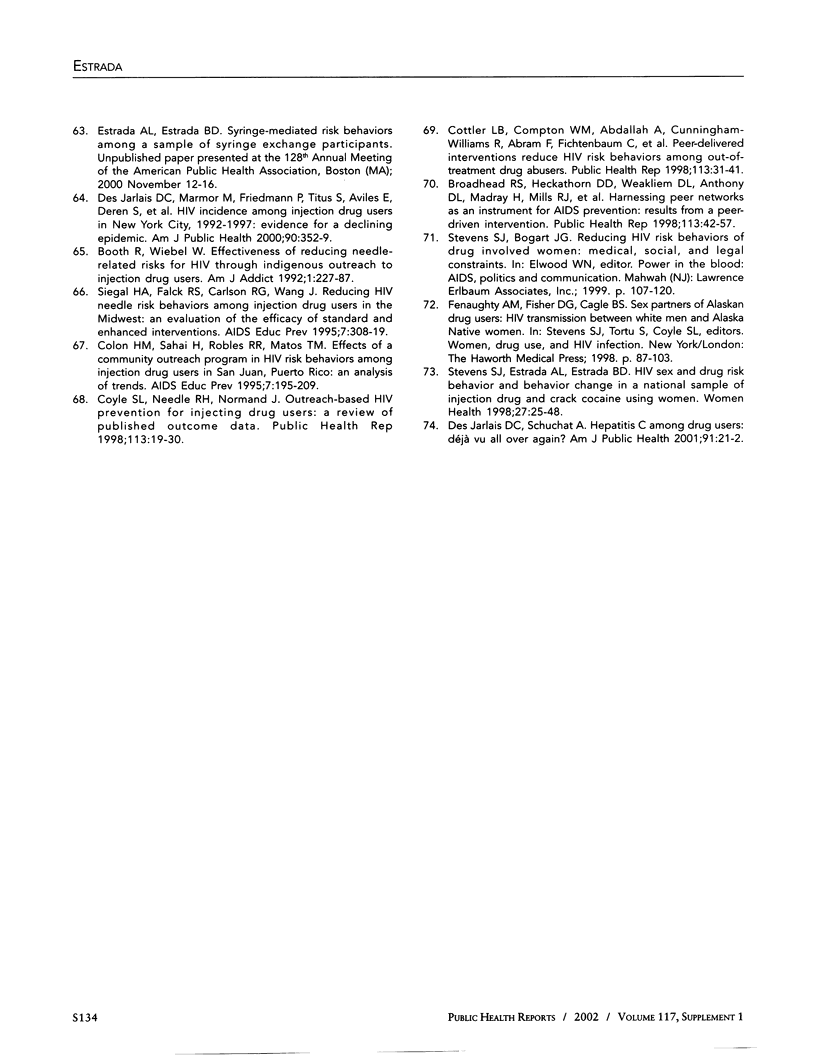Abstract
OBJECTIVE: This article reviews the literature on the impact of HIV/AIDS, hepatitis B and C viruses (HBV, HCV), and tuberculosis on minority drug injectors in the United States. OBSERVATIONS: Injection drug use is a key factor in the transmission of blood-borne pathogens, and HIV disease is exacerbated by tuberculosis infection. Minority drug injectors are disproportionately represented in the national statistics on these infections. Behavioral epidemiologic studies show that both injection-related risk factors years of injecting drugs, type of drug injected, direct and indirect sharing of injection paraphernalia) and sex-related risk factors (lack of condom use, multiple sexual partners, survival sex) are conducive to the spread of HIV, HBV, and HCV. CONCLUSIONS: Two issues must be addressed to halt the spread of HIV infection and hepatitis B and C. The capacity of syringe-exchange programs to refer participants to drug treatment programs and facilitate access to health and social services must be increased. Culturally appropriate behavioral interventions targeting risk behaviors among ethnic and racial minorities, especially women, must be developed and put in place.
Full text
PDF








Selected References
These references are in PubMed. This may not be the complete list of references from this article.
- Alter M. J., Kruszon-Moran D., Nainan O. V., McQuillan G. M., Gao F., Moyer L. A., Kaslow R. A., Margolis H. S. The prevalence of hepatitis C virus infection in the United States, 1988 through 1994. N Engl J Med. 1999 Aug 19;341(8):556–562. doi: 10.1056/NEJM199908193410802. [DOI] [PubMed] [Google Scholar]
- Alter M. J., Moyer L. A. The importance of preventing hepatitis C virus infection among injection drug users in the United States. J Acquir Immune Defic Syndr Hum Retrovirol. 1998;18 (Suppl 1):S6–10. doi: 10.1097/00042560-199802001-00003. [DOI] [PubMed] [Google Scholar]
- Bluthenthal R. N., Kral A. H., Erringer E. A., Edlin B. R. Use of an illegal syringe exchange and injection-related risk behaviors among street-recruited injection drug users in Oakland, California, 1992 to 1995. J Acquir Immune Defic Syndr Hum Retrovirol. 1998 Aug 15;18(5):505–511. doi: 10.1097/00042560-199808150-00013. [DOI] [PubMed] [Google Scholar]
- Broadhead R. S., Heckathorn D. D., Weakliem D. L., Anthony D. L., Madray H., Mills R. J., Hughes J. Harnessing peer networks as an instrument for AIDS prevention: results from a peer-driven intervention. Public Health Rep. 1998 Jun;113 (Suppl 1):42–57. [PMC free article] [PubMed] [Google Scholar]
- Cantwell M. F., McKenna M. T., McCray E., Onorato I. M. Tuberculosis and race/ethnicity in the United States: impact of socioeconomic status. Am J Respir Crit Care Med. 1998 Apr;157(4 Pt 1):1016–1020. doi: 10.1164/ajrccm.157.4.9704036. [DOI] [PubMed] [Google Scholar]
- Cantwell M. F., Snider D. E., Jr, Cauthen G. M., Onorato I. M. Epidemiology of tuberculosis in the United States, 1985 through 1992. JAMA. 1994 Aug 17;272(7):535–539. [PubMed] [Google Scholar]
- Colón H. M., Sahai H., Robles R. R., Matos T. D. Effects of a community outreach program in HIV risk behaviors among injection drug users in San Juan, Puerto Rico: an analysis of trends. AIDS Educ Prev. 1995 Jun;7(3):195–209. [PubMed] [Google Scholar]
- Cottler L. B., Compton W. M., Ben Abdallah A., Cunningham-Williams R., Abram F., Fichtenbaum C., Dotson W. Peer-delivered interventions reduce HIV risk behaviors among out-of-treatment drug abusers. Public Health Rep. 1998 Jun;113 (Suppl 1):31–41. [PMC free article] [PubMed] [Google Scholar]
- Curran J. W., Jaffe H. W., Hardy A. M., Morgan W. M., Selik R. M., Dondero T. J. Epidemiology of HIV infection and AIDS in the United States. Science. 1988 Feb 5;239(4840):610–616. doi: 10.1126/science.3340847. [DOI] [PubMed] [Google Scholar]
- Daley C. L., Hahn J. A., Moss A. R., Hopewell P. C., Schecter G. F. Incidence of tuberculosis in injection drug users in San Francisco: impact of anergy. Am J Respir Crit Care Med. 1998 Jan;157(1):19–22. doi: 10.1164/ajrccm.157.1.9701111. [DOI] [PubMed] [Google Scholar]
- Des Jarlais D. C., Marmor M., Friedmann P., Titus S., Aviles E., Deren S., Torian L., Glebatis D., Murrill C., Monterroso E. HIV incidence among injection drug users in New York City, 1992-1997: evidence for a declining epidemic. Am J Public Health. 2000 Mar;90(3):352–359. doi: 10.2105/ajph.90.3.352. [DOI] [PMC free article] [PubMed] [Google Scholar]
- Des Jarlais D. C., Schuchat A. Hepatitis C among drug users: déjà vu all over again? Am J Public Health. 2001 Jan;91(1):21–22. doi: 10.2105/ajph.91.1.21. [DOI] [PMC free article] [PubMed] [Google Scholar]
- Dhopesh V. P., Taylor K. R., Burke W. M. Survey of hepatitis B and C in addiction treatment unit. Am J Drug Alcohol Abuse. 2000 Nov;26(4):703–707. doi: 10.1081/ada-100101903. [DOI] [PubMed] [Google Scholar]
- Donahue J. G., Nelson K. E., Muñoz A., Vlahov D., Rennie L. L., Taylor E. L., Saah A. J., Cohn S., Odaka N. J., Farzadegan H. Antibody to hepatitis C virus among cardiac surgery patients, homosexual men, and intravenous drug users in Baltimore, Maryland. Am J Epidemiol. 1991 Nov 15;134(10):1206–1211. doi: 10.1093/oxfordjournals.aje.a116023. [DOI] [PubMed] [Google Scholar]
- Estrada A. L. Drug use and HIV risks among African-American, Mexican-American, and Puerto Rican drug injectors. J Psychoactive Drugs. 1998 Jul-Sep;30(3):247–253. doi: 10.1080/02791072.1998.10399699. [DOI] [PubMed] [Google Scholar]
- Fenaughty A. M., Fisher D. G., Cagle H. H. Sex partners of Alaskan drug users: HIV transmission between white men and Alaska Native women. Women Health. 1998;27(1-2):87–103. doi: 10.1300/J013v27n01_06. [DOI] [PubMed] [Google Scholar]
- Friedman C. R., Quinn G. C., Kreiswirth B. N., Perlman D. C., Salomon N., Schluger N., Lutfey M., Berger J., Poltoratskaia N., Riley L. W. Widespread dissemination of a drug-susceptible strain of Mycobacterium tuberculosis. J Infect Dis. 1997 Aug;176(2):478–484. doi: 10.1086/514067. [DOI] [PubMed] [Google Scholar]
- Garfein R. S., Vlahov D., Galai N., Doherty M. C., Nelson K. E. Viral infections in short-term injection drug users: the prevalence of the hepatitis C, hepatitis B, human immunodeficiency, and human T-lymphotropic viruses. Am J Public Health. 1996 May;86(5):655–661. doi: 10.2105/ajph.86.5.655. [DOI] [PMC free article] [PubMed] [Google Scholar]
- Hagan H., Des Jarlais D. C., Purchase D., Friedman S. R., Reid T., Bell T. A. An interview study of participants in the Tacoma, Washington, syringe exchange. Addiction. 1993 Dec;88(12):1691–1697. doi: 10.1111/j.1360-0443.1993.tb02044.x. [DOI] [PubMed] [Google Scholar]
- Hagan H., Thiede H., Weiss N. S., Hopkins S. G., Duchin J. S., Alexander E. R. Sharing of drug preparation equipment as a risk factor for hepatitis C. Am J Public Health. 2001 Jan;91(1):42–46. doi: 10.2105/ajph.91.1.42. [DOI] [PMC free article] [PubMed] [Google Scholar]
- Heimer R., Khoshnood K., Bigg D., Guydish J., Junge B. Syringe use and reuse: effects of syringe exchange programs in four cities. J Acquir Immune Defic Syndr Hum Retrovirol. 1998;18 (Suppl 1):S37–S44. doi: 10.1097/00042560-199802001-00008. [DOI] [PubMed] [Google Scholar]
- Heimer R. Syringe exchange programs: lowering the transmission of syringe-borne diseases and beyond. Public Health Rep. 1998 Jun;113 (Suppl 1):67–74. [PMC free article] [PubMed] [Google Scholar]
- Hernandez M. T., Klausner J. D., McFarland W., Wong E., Bolan G., Molitor F., Ruiz J. D. Hepatitis B prevalence in young women living in low-income areas: the population-based San Francisco Bay area's Young Women's Survey. Sex Transm Dis. 2000 Oct;27(9):539–544. doi: 10.1097/00007435-200010000-00007. [DOI] [PubMed] [Google Scholar]
- Hilton B. A., Thompson R., Moore-Dempsey L., Janzen R. G. Harm reduction theories and strategies for control of human immunodeficiency virus: a review of the literature. J Adv Nurs. 2001 Feb;33(3):357–370. doi: 10.1046/j.1365-2648.2001.01672.x. [DOI] [PubMed] [Google Scholar]
- Levine O. S., Vlahov D., Koehler J., Cohn S., Spronk A. M., Nelson K. E. Seroepidemiology of hepatitis B virus in a population of injecting drug users. Association with drug injection patterns. Am J Epidemiol. 1995 Aug 1;142(3):331–341. doi: 10.1093/oxfordjournals.aje.a117639. [DOI] [PubMed] [Google Scholar]
- Levine O. S., Vlahov D., Nelson K. E. Epidemiology of hepatitis B virus infections among injecting drug users: seroprevalence, risk factors, and viral interactions. Epidemiol Rev. 1994;16(2):418–436. doi: 10.1093/oxfordjournals.epirev.a036161. [DOI] [PubMed] [Google Scholar]
- Lifson A. R., Grant S. M., Lorvick J., Pinto F. D., He H., Thompson S., Keudell E. G., Stark M. J., Booth R. E., Watters J. K. Two-step tuberculin skin testing of injection drug users recruited from community-based settings. Int J Tuberc Lung Dis. 1997 Apr;1(2):128–134. [PubMed] [Google Scholar]
- López-Zetina J., Kerndt P., Ford W., Woerhle T., Weber M. Prevalence of HIV and hepatitis B and self-reported injection risk behavior during detention among street-recruited injection drug users in Los Angeles County, 1994-1996. Addiction. 2001 Apr;96(4):589–595. doi: 10.1080/09652140020031638. [DOI] [PubMed] [Google Scholar]
- McBride D. Tuberculosis in African-American and minority populations: historic epidemiology of a nonclassic contagious process. J Assoc Acad Minor Phys. 1994;5(1):11–15. [PubMed] [Google Scholar]
- Murrain M. Differential survival in blacks and Hispanics with AIDS. Ethn Health. 1996 Dec;1(4):373–382. doi: 10.1080/13557858.1996.9961806. [DOI] [PubMed] [Google Scholar]
- Reyes J. C., Robles R. R., Colón H. M., Marrero C. A., Castillo X., Meléndez M. Mycobacterium tuberculosis infection among crack and injection drug users in San Juan, Puerto Rico. P R Health Sci J. 1996 Sep;15(3):233–236. [PubMed] [Google Scholar]
- Rusen I. D., Yuan L., Millson M. E. Prevalence of Mycobacterium tuberculosis infection among injection drug users in Toronto. CMAJ. 1999 Mar 23;160(6):799–802. [PMC free article] [PubMed] [Google Scholar]
- Salomon N., Perlman D. C., Friedmann P., Ziluck V., Des Jarlais D. C. Prevalence and risk factors for positive tuberculin skin tests among active drug users at a syringe exchange program. Int J Tuberc Lung Dis. 2000 Jan;4(1):47–54. [PubMed] [Google Scholar]
- Sambamoorthi U., Warner L. A., Crystal S., Walkup J. Drug abuse, methadone treatment, and health services use among injection drug users with AIDS. Drug Alcohol Depend. 2000 Jul 1;60(1):77–89. doi: 10.1016/s0376-8716(99)00142-8. [DOI] [PubMed] [Google Scholar]
- Seal K. H., Ochoa K. C., Hahn J. A., Tulsky J. P., Edlin B. R., Moss A. R. Risk of hepatitis B infection among young injection drug users in San Francisco: opportunities for intervention. West J Med. 2000 Jan;172(1):16–20. doi: 10.1136/ewjm.172.1.16. [DOI] [PMC free article] [PubMed] [Google Scholar]
- Selik R. M., Castro K. G., Pappaioanou M., Buehler J. W. Birthplace and the risk of AIDS among Hispanics in the United States. Am J Public Health. 1989 Jul;79(7):836–839. doi: 10.2105/ajph.79.7.836. [DOI] [PMC free article] [PubMed] [Google Scholar]
- Siegal H. A., Falck R. S., Carlson R. G., Wang J. Reducing HIV needle risk behaviors among injection-drug users in the Midwest: an evaluation of the efficacy of standard and enhanced interventions. AIDS Educ Prev. 1995 Aug;7(4):308–319. [PubMed] [Google Scholar]
- Snider D. E., Jr, Salinas L., Kelly G. D. Tuberculosis: an increasing problem among minorities in the United States. Public Health Rep. 1989 Nov-Dec;104(6):646–653. [PMC free article] [PubMed] [Google Scholar]
- Strathdee S. A., Celentano D. D., Shah N., Lyles C., Stambolis V. A., Macalino G., Nelson K., Vlahov D. Needle-exchange attendance and health care utilization promote entry into detoxification. J Urban Health. 1999 Dec;76(4):448–460. doi: 10.1007/BF02351502. [DOI] [PMC free article] [PubMed] [Google Scholar]
- Thiede H., Hagan H., Murrill C. S. Methadone treatment and HIV and hepatitis B and C risk reduction among injectors in the Seattle area. J Urban Health. 2000 Sep;77(3):331–345. doi: 10.1007/BF02386744. [DOI] [PMC free article] [PubMed] [Google Scholar]
- Thomas D. L., Vlahov D., Solomon L., Cohn S., Taylor E., Garfein R., Nelson K. E. Correlates of hepatitis C virus infections among injection drug users. Medicine (Baltimore) 1995 Jul;74(4):212–220. doi: 10.1097/00005792-199507000-00005. [DOI] [PubMed] [Google Scholar]
- Vlahov D., Junge B., Brookmeyer R., Cohn S., Riley E., Armenian H., Beilenson P. Reductions in high-risk drug use behaviors among participants in the Baltimore needle exchange program. J Acquir Immune Defic Syndr Hum Retrovirol. 1997 Dec 15;16(5):400–406. doi: 10.1097/00042560-199712150-00014. [DOI] [PubMed] [Google Scholar]
- Vlahov D., Junge B. The role of needle exchange programs in HIV prevention. Public Health Rep. 1998 Jun;113 (Suppl 1):75–80. [PMC free article] [PubMed] [Google Scholar]
- van Ameijden E. J., van den Hoek A. R., Coutinho R. A. Injecting risk behavior among drug users in Amsterdam, 1986 to 1992, and its relationship to AIDS prevention programs. Am J Public Health. 1994 Feb;84(2):275–281. doi: 10.2105/ajph.84.2.275. [DOI] [PMC free article] [PubMed] [Google Scholar]


